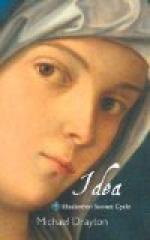MARTHA FOOTE CROW
Kegan Paul, Trench, Truebner and Co.
Paternoster House London W.C.
1897
Idea
by
Michael Drayton
Fidessa
by
Bartholomew Griffin
Chloris
by
William Smith
Idea
by
Michael Drayton
The true story of the life of Michael Drayton might be told to vindicate the poetic traditions of the olden time. A child-poet wandering in fay-haunted Arden, or listening to the harper that frequented the fireside of Polesworth Hall where the boy was a petted page, later the honoured almoner of the bounty of many patrons, one who “not unworthily,” as Tofte said, “beareth the name of the chiefest archangel, singing after this soule-ravishing manner,” yet leaving but “five pounds lying by him at his death, which was satis viatici ad coelum”—is not this the panorama of a poetic career? But above all, to complete the picture of the ideal poet, he worshipped, and hopelessly, from youth to age the image of one, woman. He never married, and while many patronesses were honoured with his poetic addresses, there was one fair dame to whom he never offered dedicatory sonnet, a silence that is full of meaning. Yet the praises of Idea, his poetic name for the lady of his admiration and love, are written all over the pages of his voluminous lyrical and chorographical and historical poems, and her very name is quaintly revealed to us. Anne Goodere was the younger daughter in the noble family where Drayton was bred and educated; and one may picture the fair child standing “gravely merry” by the little page to listen to “John Hews his lyre,” at that ancestral fireside. “Where I love, I love for years,” said Drayton in 1621. As late as 1627, but four years before his death, he writes an elegy of his lady’s not coming to London, in which he complains that he has been starved for her short letters and has had to read last year’s over again. About the same time he is writing that immortal sonnet, the sixty-first, the one that Rossetti, with perhaps something too much of partiality, has declared to be almost, if not quite, the best in the language. The tragedy of a whole life is concentrated in that sonnet, and the heart-pang in it is unmistakable. But Drayton had stood as witness to the will of Anne’s father, by which L1500 was set down for her marriage portion. She was an heiress, he a penniless poet, and what was to be done?
About 1590, when Drayton was twenty-eight, and Anne was probably twenty-one years old, Drayton left Polesworth Hall and came to London. Perhaps the very parting was the means of revealing his heart to himself, for it is from near this time that, as he confesses later, he dates the first consciousness of his love. He soon publishes Idea, the Shepherd’s Garland, Rowland’s Sacrifice to the Nine Muses, where




